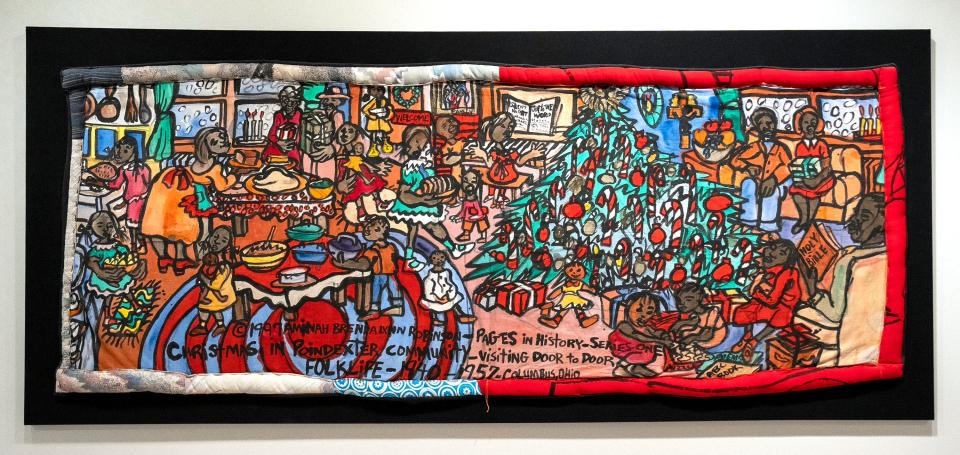Work on Columbus' first Black history museum should start this summer
- Oops!Something went wrong.Please try again later.
Work on the long-discussed museum and cultural center at the site of the Poindexter Village public housing complex on the Near East Side might begin this summer.
So far, $3.9 million in state and city money has been raised to help fund the redevelopment of the two remaining Poindexter Village buildings. And on Saturday, April 29, a volunteer group will be hosting a fundraiser for the effort at the King Arts Complex, 835 Mount Vernon Ave.
The museum would not only tell the the story of Poindexter Village — Columbus' first public housing complex and dedicated by President Franklin D. Roosevelt in 1940 — but would also be the city's first Black history museum.
"This story connects a bigger Great Migration story," said Shelbi Toone, project manager for the Poindexter Village Museum and Cultural Center, referring to when millions of Black residents left the South in the early 20th century to find jobs in the industrial North, including Columbus.
Neil Thompson, spokesman for the Ohio History Connection, said it's too early to say what the total cost will be.
"We're still in the planning stages, still getting partners," he said. The Ohio History Connection owns the property after purchasing it from the Columbus Metropolitan Housing Authority.
Michael Roberts, who chairs the board of the James Preston Poindexter Foundation, said about $4 million will be needed to complete the work.
In October, the Columbus City Council approved a $1.4-million grant for the effort. The state approved $1.425 million in 2020, then another $1 million as part of its capital budget passed in 2022, plus $65,282 in capital grants for 2023, according to Casey Rife, spokesperson for the Ohio Senate Democratic Caucus.
"We’ve begun spending the money," Toone said, including on new windows.
The Poindexter Village museum would be the Ohio History Connection's 59th historic site. State Sen. Hearcel Craig, a Columbus Democrat, introduced the legislation for that designation.
"I felt it was really important because of its geographical location in the community," Craig said. "It was certainly representative in many ways of diverse and affordable housing for the city of Columbus."
Local historian Reita Smith lived at Poindexter Village and fought to preserve all of Poindexter Village's 35 buildings. Crews began demolishing 33 of the buildings in 2013, but Smith and others were able to save two for the museum.
"All our plans were derailed by the pandemic. Of course, we're in a make-up time now," Smith said. "Hopefully, we will move forward."
Other prominent residents were artist Aminah Robinson, whose artwork included depictions of Poindexter Village, and former WBNS-TV/Channel 10 anchor Angela Pace.

Conestoga, a volunteer fundraising arm of the Ohio History Connection, is holding the April fundraiser.
Laura Ecklar, a Conestoga volunteer, said her group has raised about $24,000 so far. Roberts said the goal is to raise $40,000-$45,000 by April through this effort, while approaching other sources for donations to pay the total cost.
Ecklar said that Conestoga members decided its annual fundraiser should be for Poindexter Village after hearing more about it and its place in the city's history.
"We just realized how important it is to preserve, historically and culturally, to Columbus," Ecklar said.
"It will be a great asset to Columbus and Ohio when it’s completed. A great cultural center and educational center," she said.
Kate Curry-Da-Souza, who leads the Near East Area Commission, said it is important for the historic buildings to be maintained. She said the neighborhood welcomes the museum and is open to what else it could be used for, perhaps meeting space.
Kathleen Bailey, a longtime Near East Side resident who used to lead the area commission, said she hopes the museum could bring people to the neighborhood, much like the Paul Laurence Dunbar House in Dayton, a museum for the renowned Black writer that Bailey has visited.
"It would be an excellent place for teachers for trips," she said.
Columbus City Council President Shannon Hardin said the museum could also draw visitors to the Mount Vernon Avenue and East Long Street corridors, helping to drive economic development.
"There's so much rich African-American history we want to be shared," he said.
For information on the fundraiser, go to: ohiohistory.org/get-involved/donate/conestoga.
mferench@dispatch.com
@MarkFerenchik
This article originally appeared on The Columbus Dispatch: Work on Columbus' first Black history museum should start this summer

